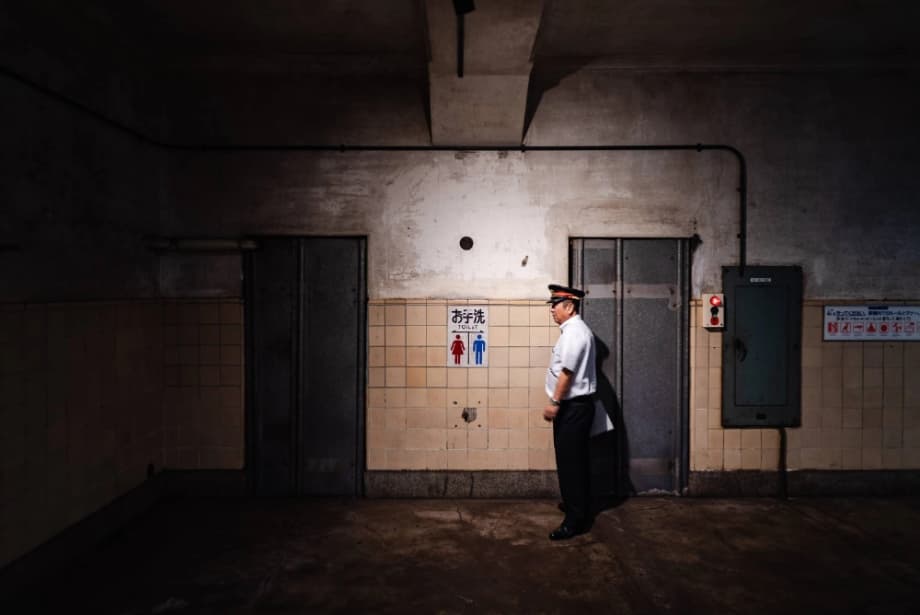Beneath the city, Tokyo’s hidden stations come to light
The roar of the Keisei Skyliner grows as it enters a tunnel beneath Ueno Park. Inside its bright cars, travelers bound for Narita Airport glance at phones and suitcases. Just outside the train’s windows, a dark platform flickers past. The concrete is stained by decades of soot. A faded high speed rail poster curls at the edges. A small wooden booth where a clerk once punched paper tickets sits shuttered, coated in dust. The train never stops. This is Hakubutsukan Dobutsuen Station, a disused stop on the Keisei Main Line that once channeled day trippers to Ueno Zoo and the museum district. It opened in 1933, remained in service for decades, then fell silent in the late 1990s. What remains is a preserved slice of the city’s transit past, right below one of Tokyo’s busiest parks.
- Beneath the city, Tokyo’s hidden stations come to light
- What is a phantom station
- Hakubutsukan Dobutsuen, the museum and zoo gateway that stopped in time
- Shimbashi’s short lived Ginza Line platform
- Manseibashi, from grand terminal to riverfront landmark
- Why stations become ghosts in Tokyo
- Preservation, safety, and public access
- From legends to literature
- Highlights
Station staff who know the site warn visitors on special tours to mind the iron dust, oil, and mud that still cling to surfaces. The platforms and tunnels were left as they were, aside from seismic reinforcement. At street level, a striking neoclassical entrance stands like a relic from another era. Massive emerald green sliding steel doors face Ueno Park. A pyramid like roof and dome crown a vestibule where wide staircases descend to the cool, musty underground. Inside, the mix of mystery and urban wear speaks to the long arc of a city that kept expanding, rerouting trains and closing stations as patterns changed. Rumors whisper of wartime factories or an imperial carriage once stored here, though nothing has been confirmed.
These so called phantom stations sit behind walls, doors, and darkness, but they remain etched into the daily map of the city. They are industrial diaries in concrete, brick, and steel. Some platforms were built for a moment that passed quickly. Others thrived, then faded as new terminals and longer trains took over. Ueno’s hidden stop is one of several places where Tokyo’s modern network overlies forgotten plans and platforms, including a sealed platform under Shimbashi and the evocative remains of Manseibashi along the Kanda River.
What is a phantom station
A phantom station, often called a ghost station, is a railway or subway stop that is closed, never opened, or otherwise sits unused while trains still pass by. Some stations were shuttered when passenger demand fell or when new lines and terminals reshaped routes. Some were never put into service after plans changed. In other cases, war or disaster forced temporary closures that later became permanent. The platforms and tunnels linger for decades, hidden in plain sight beneath the city.
Large rail networks have examples of unused stations, from Berlin’s Cold War era stops behind border checkpoints to sealed platforms in London and Paris. Tokyo has its own story. Here, layers of private railways, a city subway that grew line by line, and postwar rebuilding created a dense and adaptive system. Stations that once made perfect sense became unneeded when better connections appeared or when safety standards demanded longer, wider platforms. The result is a handful of places where a train window offers a split second view of a platform that no longer welcomes riders.
Hakubutsukan Dobutsuen, the museum and zoo gateway that stopped in time
Hakubutsukan Dobutsuen Station opened in 1933 to serve Ueno Park’s cultural core. The land then fell under the imperial estate, so the project required special approval, and the design went through the architecture division of the former Ministry of Railways to ensure a dignified look. The entrance reflects that heritage. It presents a formal facade to the park, but behind those doors the station feels far more utilitarian. Soot stained walls and bare concrete show decades of use. In its earliest years, crowds headed to the Tokyo Imperial Household Museum and the zoo filtered through its gates, making it a gateway to the park’s museums and animal enclosures.
The station never received major upgrades. For many years it used wooden turnstiles, long after more modern equipment had become common elsewhere. Students from the nearby Tokyo University of the Arts painted murals of animals, including an elephant and penguins, that gave the subterranean space a gentle spark. The platform could accommodate only short four car trains, and that limitation became a problem as the Keisei line lengthened trains to move more people safely. Ridership ebbed as passengers favored other stations, especially Keisei Ueno, which lies just 900 meters away. Limited hours and a single attendant marked the final years of operation.
Service ended in 1997 and the station was formally closed in 2004. The underground area remains as a time capsule, aside from earthquake reinforcement. In 2018, the Tokyo Metropolitan Government designated the site a historical building, the first time a railway facility received that status in the city. Collaborations since then have revived the street entrance, including a freshly designed green door by artist Katsuhiko Hibino that nods to the original color scheme. Inside, the preserved environment tells its own story through grime, signage, and the geometry of a compact platform that could not keep pace with a growing metropolis.
How to see it today
The underground platform is not part of regular service and remains closed to everyday visitors. On limited occasions, the operator has guided small groups through the space as part of special programs. From Keisei trains departing Ueno, riders can sometimes spot the darkened platform as the line heads toward Nippori. The formal entrance near Ueno Park has been refreshed at street level, offering a glimpse of the architecture that framed journeys to the zoo and museum district.
Shimbashi’s short lived Ginza Line platform
Beneath one of Tokyo’s oldest railway hubs lies another ghost of a plan that changed. Behind a plain metal door near Exit 8 of the Ginza Line at Shimbashi is a hidden platform completed in 1939. It was used for only about eight months. Disagreements between railway companies halted the original idea, which left the platform orphaned. During the war, the space reportedly served as a turnaround point when bomb damage disrupted standard operations.
That wartime use left a trace in Tokyo’s underground history. The sealed area shows how transit builders often attempted ambitious expansions and backups, but compromises and circumstance had other ideas. Today, passengers walk past the nondescript door unaware that a platform waits behind it. The site is not open to the public and remains a fragment from a version of the Ginza Line that might have been.
Manseibashi, from grand terminal to riverfront landmark
Walk along the Kanda River and the red brick arches of Manseibashi come into view. The site once housed a grand terminal on the Chuo Line. Designed by Kingo Tatsuno, the famed architect behind early icons of modern Japan, Manseibashi opened in 1912 and quickly became a major node for streetcars, suburban rail, and commerce. The Great Kanto Earthquake in 1923 devastated central Tokyo, and the rebuilding that followed shifted focus toward the new hub at Tokyo Station. Manseibashi’s role faded over the following decades, and the station closed in 1943.
Railway culture carried on at the site in another form. The Railway Museum and later the Transportation Museum occupied the area, telling the story of Japan’s trains to generations of visitors. When the Transportation Museum closed in 2006, the site began a new chapter. In 2013, the arches and viaduct were restored, and the remains of the platforms and stairways were woven into a commercial space with cafes and design shops. Visitors can climb original staircases and stand where passengers once waited. The care taken to preserve over a century of craftsmanship is easy to spot in brickwork and stone details. Overhead, trains still rumble by, their sound folded into the steady pulse of the city.
Two Manseibashi stories
The name Manseibashi holds two pieces of hidden subway history. In the tunnels of the Ginza Line, a separate phantom platform named Manseibashi operated as a temporary stop from January 1930 to November 1931 while Kanda Station was under construction. For decades it sat dark while trains slipped past. In a rare move, the operator illuminated this concealed platform for a short period in 2017 so riders could glimpse it as they passed. During the same period, a decommissioned platform from the old Jingumae Station, now part of Omotesando Station, was also lit for riders. The riverfront site and the subway phantom are different places with the same name, both illustrating how central Tokyo’s rail grid kept evolving across the twentieth century.
Why stations become ghosts in Tokyo
Tokyo’s rail network is a complex mesh built by different companies over many decades. Private railways feed suburban riders into the city core. The subway crisscrosses downtown. Japan Rail lines still follow routes that date to the late nineteenth and early twentieth centuries. With so many overlapping lines, change is constant. New hubs rise, older stops lose passengers, and shorter platforms that once worked well no longer meet safety and capacity needs. War and earthquakes forced difficult choices. Corporate disagreements reshaped plans underground. Each phantom station is a record of a decision made to serve passengers better, or a project halted by events outside the tunnel.
- Platforms proved too short for longer trains and modern safety rules.
- New terminals and transfer points shifted commuters to more convenient stops.
- War damage and disaster recovery changed priorities and routings.
- Company plans conflicted, leaving finished platforms without a role.
- Stations that sat close together made service slower and less efficient.
- Modernization moved resources to high demand corridors.
The rise of high speed rail did not create these ghosts, but it did reshape the broader map. As Shinkansen lines linked regions more tightly, Tokyo’s intercity focus concentrated around major terminals, while local operators refined urban networks for frequent, reliable service. That pressure rewarded flexible infrastructure and made cramped, aging stops less attractive. Where history and structure allowed it, some spaces were converted to new public uses. Others were sealed and left intact.
Preservation, safety, and public access
Phantom stations can be alluring. They mix nostalgia, architectural detail, and a touch of secrecy. Safety and legality come first. Most of these spaces are off limits and protected for good reasons. Platforms were not built to modern standards. Tunnels can collect dust and oil over time. Emergency egress must remain clear for trains that pass through. Any visit should happen only through organized events and official tours. Do not trespass. Train operators and station managers balance public interest with safety and operations.
Hakubutsukan Dobutsuen’s 2018 designation as a historical building reflects a wider appreciation for the cultural value of old rail spaces. The entrance has been carefully refreshed, but the underground remains a preserved work site, with seismic improvements that respect the original form. At Manseibashi, thoughtful reuse allows visitors to walk along original stairs and platforms without stepping into live track areas. This kind of conversion keeps history visible and useful while protecting riders and staff.
Anyone curious about Tokyo’s hidden stations has several safe options. From Keisei trains, watch for the dark platform between Ueno and Nippori. Walk the riverfront arches at Manseibashi and step onto sections of the original platform that have become part of a public space. Keep an eye on seasonal programs, since operators occasionally illuminate or open sealed platforms for a limited time. At Shimbashi, the door near the Ginza Line’s Exit 8 hints at an unseen platform, but it is not open to visitors.
From legends to literature
Japan’s railways carry more than commuters and tourists. They carry stories. Some stations across the country are known for eerie reputations, like the deep, echoing platforms of Doai Station in Gunma or the quiet underpass at Kokudo in Yokohama with scars from wartime. In Tokyo, urban legends swirl around massive hubs like Shinjuku after midnight. Those sites fall into a different category than phantom stations, but they spring from the same mix of history, isolation, and imagination that old tunnels inspire.
Writers have found powerful settings in the spaces around Ueno Park. Yu Miri’s novel Tokyo Ueno Station follows a man who slips through life’s margins, linking the park, the station area, and the city’s cycles of celebration and hardship. The story reflects on homelessness, loss, and the distance between the center of power and the everyday workers who built modern Tokyo. The novel’s attention to the park and its surroundings, including spaces that many people ignore, gives these neighborhoods a voice beyond their role as transit nodes.
That fascination says something about how cities remember. Hidden platforms and sealed doors are physical traces of an earlier plan. Reused arches and revived entrances welcome new crowds into historical spaces. Whether through literature, photography, or guided visits, Tokyo’s phantom stations help residents and visitors see how the capital grew and how it continues to adapt while carrying layers of memory below street level.
Highlights
- Hakubutsukan Dobutsuen Station opened in 1933 to serve Ueno Park and closed to traffic in 1997, with formal closure in 2004.
- The station’s neoclassical entrance stands on former imperial land and required special approval and a dignified design.
- In 2018, it became the first railway facility named a historical building by the Tokyo Metropolitan Government.
- Keisei trains still pass the dark platform between Ueno and Nippori, while the preserved interior remains closed except for special programs.
- A sealed Ginza Line platform under Shimbashi was used for only about eight months in 1939, then saw wartime use as a turnaround.
- Manseibashi’s red brick viaduct opened in 1912, closed in 1943, and was restored in 2013 as a riverfront complex with preserved stairs and platform sections.
- A separate Ginza Line phantom platform named Manseibashi was briefly illuminated in 2017, along with a decommissioned platform at Omotesando.
- Common reasons for phantom stations include short platforms, route changes, safety standards, war damage, and overlapping stops.
- Public access focuses on safe, organized events and adaptive reuse, not trespass into closed tunnels or platforms.
- Tokyo’s phantom stations connect transit history with culture, appearing in literature and shaping how the city remembers its past.












